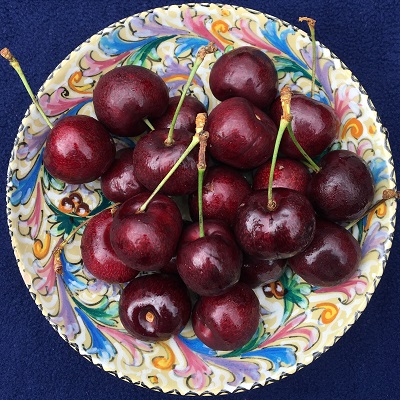 The Picota cherry is an often-underrated variety from the west of Spain. It is unusual because it is sold without stalks, and, as a result, is good value compared to conventional varieties. The berry is of medium-red colouration, with a smooth to slightly dimpled surface. The stone is fairly large in relation to the berry size, and the flesh is quite firm. The flavour and sweetness of Picota cherries is very attractive and can be eaten in considerable quantities, as with most cherries.
The Picota cherry is an often-underrated variety from the west of Spain. It is unusual because it is sold without stalks, and, as a result, is good value compared to conventional varieties. The berry is of medium-red colouration, with a smooth to slightly dimpled surface. The stone is fairly large in relation to the berry size, and the flesh is quite firm. The flavour and sweetness of Picota cherries is very attractive and can be eaten in considerable quantities, as with most cherries.
The actual variety used to produce the Picota cherry is called Ambrunes, which is grown widely in many areas of Spain. The name ‘Picota’ only applies to the cherries from the Jerte Valley, so the variety stated on labels of fruit from outside this area will be ‘Ambrunes‘ only.
Supermarkets in UK have often chosen to sell Picota as a ‘value’ option, but this doesn’t detract from the enjoyment of an attractive fruit.
Good Fruit Guide Rating: ****
Consumers will be certain to find Picota cherries very difficult to stop eating, and great value.
Sweet, stalkless, great value.
Names: Picota; Ambrunes; Negro; Colorado
Origin: Picota cherries are unique to the Jerte Valley in western Spain and are protected by a denomination of origin (DO) certificate. This verifies the fruit has been grown, harvested and packed under rigorous quality control procedures.
Grown in: Picota cherries come from a distinct area in Spain, the Jerte Valley, Extremadura – half-way between Madrid and the Portuguese border. Picota cherries are grown by around 5,000 local producers, who farm small areas of land – an average six acres for each. It is common to find three generations of the same family working on a Picota cherry farm.
Harvest & Availability: Picota cherries are available from mid-June to end-July.
- January:
- February:
- March:
- April:
- May:
- June: Spain
- July: Spain
- August:
- September:
- October:
- November:
- December:
Websites:



